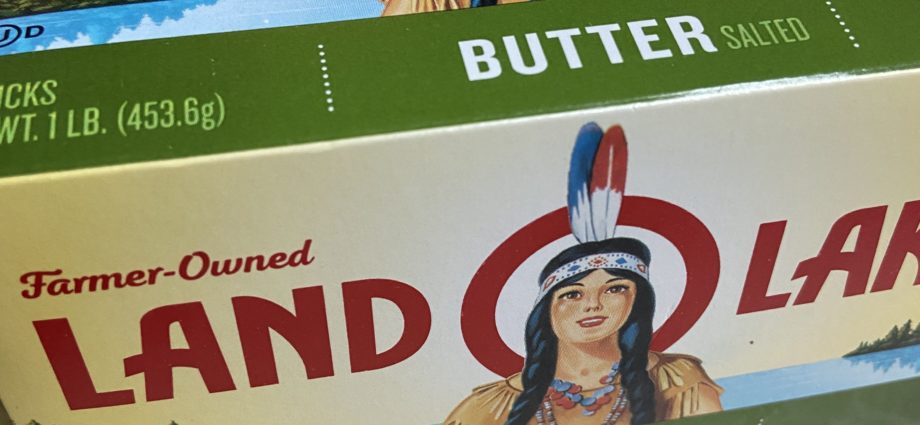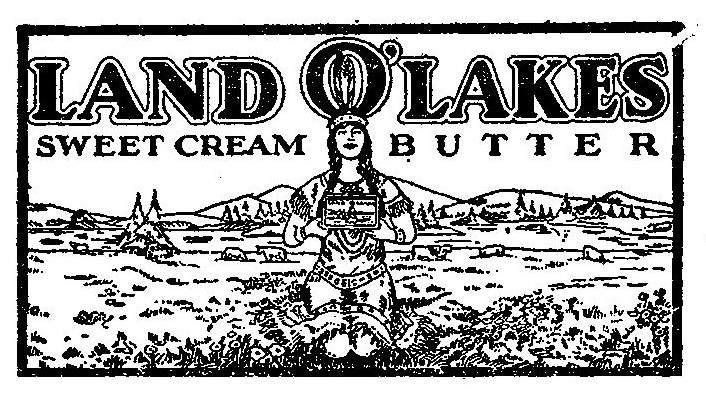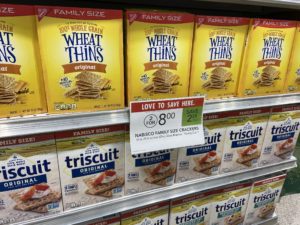It has now been just over two years since Land O’ Lakes announced the removal of its Indian maiden logo. The move turned the what was a grand symbol of American agriculture into a minimalist red O-hole. Dairy sales are down since the decision, though to be fair it should be noted that a contributor to decreased sales is the wind-down of a Covid home cooking boom.
The Arden Hills, Minnesota dairy co-op said in an April 28, 2022 press release that dairy earnings were “below prior year levels as retail volumes normalized from elevated levels during the pandemic but were partially offset by improved performance in Foodservice and higher margins on consumer cheese.”
No matter the cause, it is hard to see what was accomplished by the banishment of the Indian maiden, and the creation of its replacement, what can truly be described as a red O-hole. To add insult to this injury, the product brand, sans Amérindienne, is now appearing outside of dairy shelves, in cheap, pre-packaged cocoa mix packages (seen here in a Florida Publix store).
Is it any wonder that dairy sales are down?

Overall, Land O’ Lakes most recent quarterly report says that the co-op is far healthier financially, for other reasons. The fertilizer and dairy co-op has had a decent run since the decision to remove the maiden, in spite of the decision’s unpopularity with consumers. In the first quarter of 2022, they reported net sales totaling $5 billion, with net earnings of $179 million for the first quarter ending March 31, 2022. That compared to net sales of $3.9 billion and net earnings of $136 million in first-quarter 2021. The increase was attributed to WinField United, a Land O’Lakes subsidiary that is a wholesale supplier of crop protection inputs, seed and crop nutrients.
The company’s 2021 earnings “remained elevated from pre-pandemic levels” but dairy earnings were below prior year levels “due to higher supply chain costs, partially offset by improved margins on both cheese and nonfat dry milk.”
The co-op heralded the move in April 2020. It came just in time for Covid lockdowns. The media gushed. It took awhile for consumers to pay attention. Early on, earnings and sales in 2020 were higher due to “strong sales of our retail products including butters and spreads” and the company’s Kozy Shack products.
Ironically, it was a female CEO and president, Beth Ford, who removed the maiden in 2020. The relocation to the trademark dustbin was couched in the most noble terms:
“As Land O’Lakes looks toward our 100th anniversary, we’ve recognized we need packaging that reflects the foundation and heart of our company culture – and nothing does that better than our farmer-owners whose milk is used to produce Land O’Lakes’ dairy products.”
Logo Dates from 1920s

The logo design had a history that had nothing to do with exploiting natives. Land O’Lakes began in 1921 as the Minnesota Cooperative Creameries Association, a dairy co-op. The name dates from 1924, according to Hal Morgan’s Symbols of America. Trademark 197,022 was issued to Land O’Lakes; the mark’s first date of use was February 1, 1924. The first law firm representing the co-op was Mida & Wallace of Chicago, with attorneys Lee W. Mida and Arthur E. Wallace.
The U.S. Patent and Trademark Office has a date of January 1, 1928 for the princess logo appearing on a wide variety of goods, including butter, hog feeds, skim milk powder, chocolate malted milk, ice cream, turkeys, swiss spread, evaporated milk, poultry feed, eggs, frozen eggs and dried albumen. Land O’Lakes Creameries Inc.’s President John Brandt’s name is on the trademark certificate. Michael J. Doherty, Wilfred E. Rumble, Charles Bunn, Pierce Butler, and Francis Butler, with offices in the Merchants National Bank Building in St. Paul, are listed as representatives.
The packaging evolved over the decades (see images in slideshow below), but the Indian maiden has always been among the pantheon of great advertising mythological figures. She is as well or better known than Green Giant, Mr. Clean, Mr. Peanut, Ronald McDonald, Big Pen man, Speedy Alka-Seltzer and Tony the Tiger.
Losing at Logo Games

With a minimalist O-hole, and no image of native Americans on the package, one wonders how Americans have improved morally since the removal of a fictional, beautiful Indian princess. The company gave a nebulous reasoning for its removal; there were no great boycott campaigns calling for it. And there was no legal reason for it, either.
What may have begun the discussion about the removal, however, was the 2014 U.S.P.T.O. rejection of the Washington Redskins trademark. While the decision was unconstitutional, and political, the damage was done. Logos that might seem to be somehow native American could be tossed off at a moments notice, if a company had a weak disposition.
The team chose to remove its logo much later, for political reasons.
A 2017 Supreme Court case, Matal vs. Tam, affirmed any company’s ability to hold on to controversial trade marks. With the case, the court ruled that the U.S. Patent and Trademark office, under Joseph Matal, abridged the First Amendment rights of musician Simon Tam, who is Asian, by denying his group a trademark for the band name Slants. The case was argued by attorney Ronald Coleman, now of the Dhillon Law Group; a discussion of the implications is HERE.
Case Against Removal
The Land O’Lakes logo change sent a number of unintended messages.
- First, the removal showed that Land O’Lakes was no longer consistent, and would abandon something it had been for generations. Consumers remember that the brand had an Indian princess on it; removing her does nothing to change that memory, which will be fixed for the next half century.
- Second, the removal conveyed the message that it was not interested in everyday Americans, who see nothing offensive about the package. That a few tribal leaders thought it was offensive does not make it true. The idea that it was offensive came from academia, funneled through marketing people. And ultimately, the decision about the removal was made by the company, not tribal leaders.
- Third, and most importantly, the erasure of the maiden makes the whole memory of America’s earliest inhabitants nil. For decades, Americans bought their butter, and saw an idealized version of American Indians. Today, they do not see that image. In fact, they see no image at all. The native, then disappears.
The co-op is in a fix. The logo is now bland, and missing what gave it its appeal. At the same time, there are new, start up regional dairy brands from across the nation, and even Ireland and New Zealand. These new brands have the potential to move Land O’Lakes out of the minds of American consumers, a place they had for a century.
The Indian princess removal has not been the only change at Land O’Lakes. As the cooperative has grown mega-corporate in recent decades, it lost a diversity of suppliers. At its height in the 1970s, they served 375,000 family farmers. Herds were as small as 35. Today, they only have 1,711 dairy producers, 744 other producers, 989 co-op members, for a total of 3,444 members.
Land O’Lakes is an adept organization; its website and public relations efforts well executed. And while its network of family farms smaller than it was, it still provides financial security to associated farms, families and towns.
The challenge is that no matter how skilled the P.R. and marketing, they are missing their endearing ambassador who had earned the trust of Americans for over a century.
It is time to bring her back.


















Excellent and informative article, thank you. I didn’t know about BrandlandUSA before finding this looking specifically for this topic.
Why would any Indian Tribe or leader find this staple of American history being relayed on a package of butter offensive, is beyond me. To complain about this is to complain about the heritage of the Indians. She was a representative figure reminding the people who purchased the product the pride of the American Indian.
Since I have now noticed that she is gone, I will cease buying anything from Land-O-Lakes, which I am sorry to say was a lot. I will find an alternative to your product as I did for Aunt Jemima syrup. People who complain of these portraits of these famous people are degrading them by removing them from sight. That is a shame.
They represented their peoples and their pride of who they were, whether your liked their story or not. Land-O-Lakes, you are in the business of distributing a product to the American People, when you become a politician by falling in line with the woke folk you and your product of quality – no longer exists. Good luck to you.
The fact that the O is completely empty only serves to remind us of a companies heritage was challenged by and ultimately caved to the ideas of a group of people. To not redesign the logo and put something else in it’s place is beyond me. I wonder how many of the people who complained about the trademarked maiden actually started buying the product after it was removed.
In my household, it wasn’t the end of covid that potentially harmed the sales of Land O Lakes. It was that people like myself, and my professional baker exwife stopped buying it completely because of who the company aligned themselves with. When your political values are reflected in your packaging, I stop buying as do many others. It’s akin to what one does in a bedroom – it doesn’t need to be on display for all to see and neither do politics.
I don’t buy Aunt Jemimah’s or Uncle Ben’s products anymore either for the same reasons.
Well said. It is important to erase all of
our fond memories !